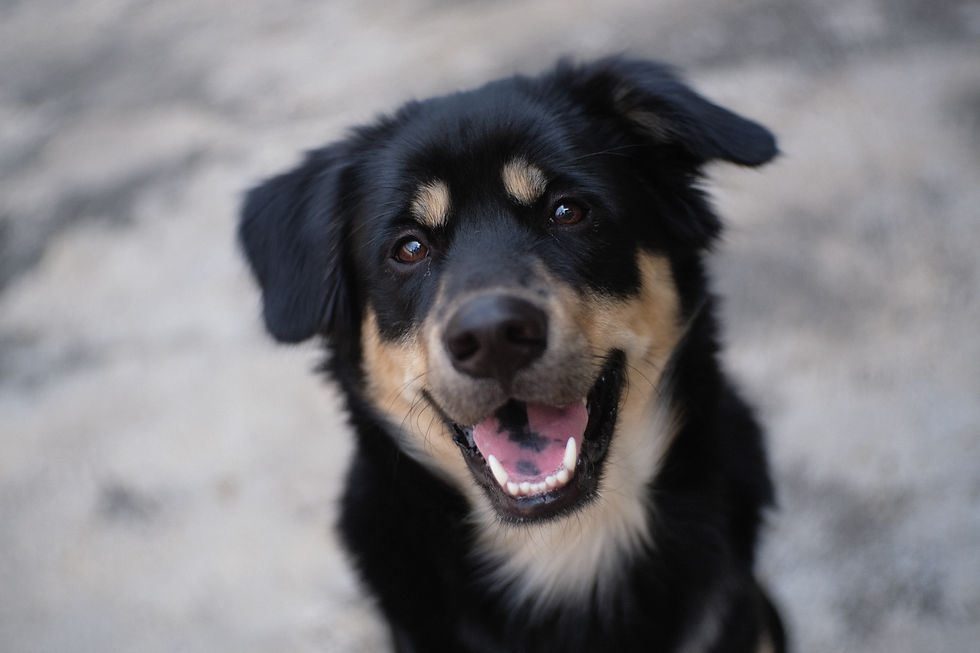Anesthesia-Free Dentals vs. Veterinary Dental Cleanings: Which Is Best for Your Dog?
- Diamond's Friends Pet Rescue

- Jun 8
- 4 min read

Dental health is crucial to your pup’s overall well-being. Two main options are available when it comes to professional dental care, including anesthesia-free cleanings and veterinary dental cleanings. Each has its perks and pitfalls.
Here’s what you should know when deciding which one is right for your dog.
What Is an Anesthesia-Free Dental Cleaning?
Anesthesia-free dental cleanings are performed by trained technicians while your dog is fully awake. The American Veterinary Dental College reports that these procedures focus primarily on removing visible plaque and tartar from the surface of the teeth using hand tools.
There’s no sedation involved, so it’s less invasive, which is a huge appeal for most dog owners.
How Often Should They Be Done?
These cleanings are often recommended every six to twelve months. Smaller dogs who tend to accumulate tartar faster may benefit from more frequent visits.
Pros of Anesthesia-Free Dentals
There are perks of opting for anesthesia-free dentals, including:
Lower cost: Generally, these are cheaper than full veterinary cleanings.
No anesthesia risk: Great for senior dogs or pets with health conditions that make sedation riskier.
No recovery time: Your dog walks in and out the same day with no grogginess or post-op care.
Quick and convenient: Often offered at grooming salons or pet retail stores.
Cons of Anesthesia-Free Dentals
However, there are also downsides to choosing this type of dental care:
Can miss disease: Gum disease starts below the gumline and can go completely unnoticed during awake cleanings.
May be stressful or painful: Some dogs find the process scary or painful without sedation.
No X-rays: There’s no option to get X-rays with anesthesia-free dentals.
Surface-level only: These cleanings are not as thorough.
According to the AVDC, anesthesia-free cleanings are not a substitute for professional veterinary dental care because they don’t allow for a thorough oral exam or treatment of disease.
Learn More: How To Take Care of Your Dog's Teeth at Home
What Is a Veterinary Dental Cleaning?
Veterinary dental cleanings are performed under general anesthesia. Your vet will:
Conduct an exam of your dog’s teeth, gums, and oral tissues.
Scale and polish the teeth above and below the gumline.
Remove or treat infected or loose teeth, if needed.
Potentially take X-rays, if needed or requested.
Since your dog is anesthetized, the vet can do a deep, thorough cleaning with zero discomfort to your pup.
How Often Should Veterinary Dental Cleanings Be Done?
Most veterinarians suggest teeth cleanings annually. As with anesthesia-free dentals, small dogs may need more frequent cleanings.
Pros of Vet Dental Cleanings
There are benefits of having your veterinarian clean your dog’s teeth, including:
Better outcomes: Can slow or even reverse periodontal disease if caught early.
Can get X-rays: If needed or requested, these allow for the diagnosis of issues invisible to the naked eye.
Comprehensive care: Treats gum disease, infections, and other hidden issues.
Less stress during the procedure: Your dog sleeps through the entire thing, eliminating anxiety or pain.
Cons of Vet Dental Cleanings
But, there are some concerns that come along with veterinary dental cleanings, like:
More expensive: The cost can range from $500 to $1,500 or more depending on location, X-rays, and extractions.
Post-op recovery: Your dog may be groggy for a few hours afterward.
Requires anesthesia: Sedation always carries some risk, though it's low when properly managed.
From a doggy wellness perspective, the anesthesia risk is usually the most concerning part of these types of dental cleanings. That said, VCA reports that the risk of dogs dying from anesthesia is .17%. So, while the worst-case scenario can happen, it’s rare.
So…Which One Is Better?
In our opinion (and again, this is just our opinion), if your dog can safely undergo anesthesia, we feel that regular dentals with your veterinarian are superior in terms of making sure your dog doesn’t develop any significant issues. Just make sure to do pre-anesthesia bloodwork first.
However, the answer to this question may depend on your goals and your dog’s health:
If you’re aiming for cosmetic touch-ups between full dentals and your dog is cooperative, an anesthesia-free cleaning may help maintain surface cleanliness.
If you want real preventive care and diagnosis, a veterinary dental cleaning under anesthesia is the gold standard.
Think of anesthesia-free cleanings like brushing your teeth at home. It helps, but it doesn't replace going to the dentist for a deep cleaning and X-rays.
The best plan? Talk to your vet. They can help assess your dog’s risk, recommend a cleaning schedule, and let you know when it’s time to go beyond the surface.
Learn More: How To Choose a Veterinarian
Final Thoughts
Investing in proper dental care can help your pup avoid pain, tooth loss, and even systemic health issues down the road.
Whether you opt for anesthesia-free cleanings, full veterinary procedures, or a combo of both, staying on top of dental care is one of the best things you can do for your dog’s long-term health.
Disclaimer: This article is not intended as professional medical advice. It is based on personal experience and online research. Please consult with your veterinarian if you are concerned about your dog's health.
Sources
Montana Pet Denistry & Oral Surgery. (2025, May 12). How Often Should Dogs Get Their Teeth Cleaned? Retrieved from https://montanapetdentist.com/how-often-should-dogs-get-their-teeth-cleaned/
AVDC. (n.d.). Pet Periodontal Disease. Retrieved from https://afd.avdc.org/pet-periodontal-disease/
AVDC. (n.d.). Reasons Not To Choose Anesthesia Free Dentals for Your Pet. Retrieved from https://afd.avdc.org/reasons-not-to-choose-anethesia-free-pet-dentals/
Masson Veterinary Hospital. (n.d.). Understanding Anesthesia-Free Dog Teeth Cleaning: Benefits and Risks. Retrieved from https://sanbrunovet.com/dental-pet-care-in-san-bruno-ca/understanding-anesthesia-free-dog-teeth-cleaning-benefits-and-risks/
Weir, M., et al. (n.d.). Anesthesia for Dogs. Retrieved from https://vcahospitals.com/know-your-pet/anesthesia-for-dogs



Comments